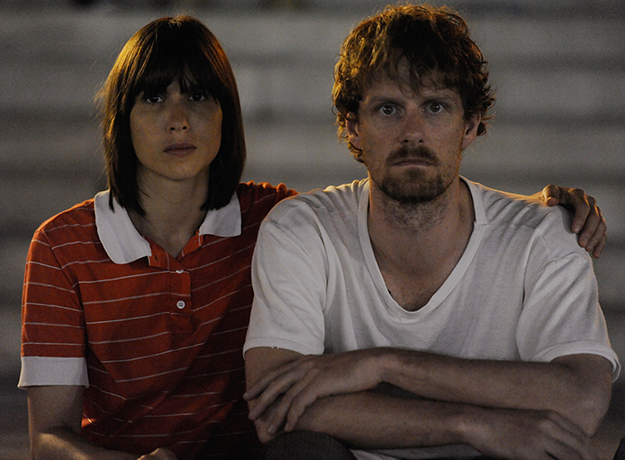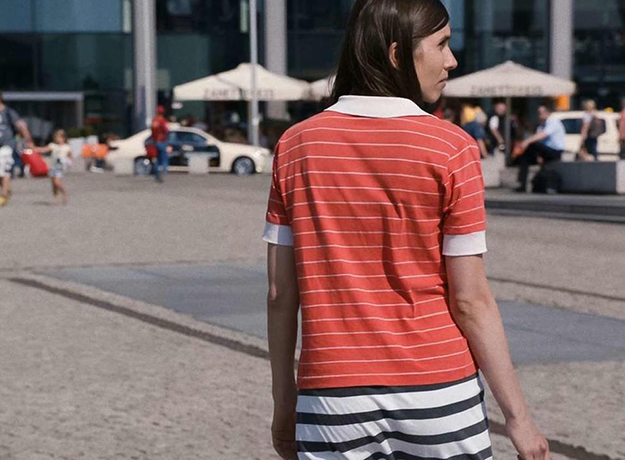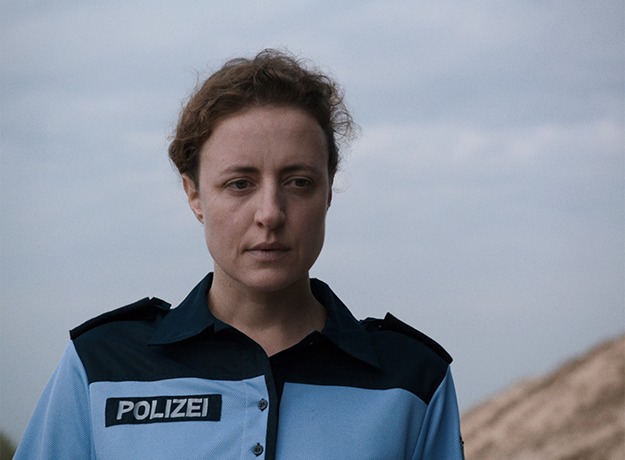Interweaving the couple’s seemingly disparate dramas, Schanelec masterfully condenses time and consolidates information, drawing parallels between the couples’ entwined destinies through discreet visual correlations and suggestive behavioral rhythms. The early-’80s story follows the vagabond pair Theres (Miriam Jakob) and Kenneth (Thorbjörn Björnsson) as they attempt to maintain their relationship and artistic aspirations while family sickness and professional developments threaten to pull them apart. In the story set in present-day Berlin, Ariane (Maren Eggert) and David (Phil Hayes) deal with personal issues of their own that eventually lead to a separation. Schanelec sat down with Film Comment following the North American premiere of The Dreamed Path at the Toronto International Film Festival to discuss her process, her influences, and her relationship to books and poetry.
Your films tend to feature very fragmented, elliptical narratives. I’m curious how they get to that point: When conceiving of the film do you start with an image, or a word—or do you indeed start with a character or concept? It’s really different each time. There are films that I’ve made where I have had a dialogue in mind, or the beginning of a dialogue. With The Dreamed Path, there were images, a few images actually, which were a starting point in my imagination. The homeless character, Kenneth, was one of the first characters I thought about, but very soon there were those two couples. The film jumps in time very discreetly a number of times. Can you talk about how you think about time cinematically and how you choose to depict time formally? Well, for one, this is not a conceptual film. But nevertheless the formal aspects are very obvious, or strong—which is essential because I’m telling the story with the form. The writing process and the process of finding the images is a very intuitive process. Concerning the time, I first thought about the parts of the story set in recent times, through what is currently happening in Berlin. So while I first thought of Kenneth, this homeless man, I began to think that I’d like to see him as a young man. He’s in his fifties in the current part of the story, so that would put him in his early twenties in the first section of the film, set in the 1980s. So you went backward to find the narrative? Yes. But you also decided to use the same actors for each part of the film, and thus there’s no differentiation as to their age. How did that idea develop? Well, hopefully the viewer understands that the film starts in the ’80s and in the end we see the same persons today. If he understands that, then he understands that they also have to get older, so why do I have to show that, through makeup or some other effect? Filmmaking can be about that but it doesn’t have to be. It seems important that each of your images carries an emotional core. Even if the viewer can’t rationally place in the image within the greater narrative, there’s something striking and self-contained about each individual shot. I’m happy to hear you say that. That’s how I think about the images. The film is composed of images. And though you could say, well, every film is composed of images. But what does that really mean? If you take the idea very seriously, and begin to ask yourself how the image has to be, how it has to be framed and everything—this sounds very general but if you see the film, then you will understand what I mean.
As far as composing individual shots, is there any room for improvising from the actors? No, there’s no room at all. [Laughs] The images in the film are generally prepared before. So when I’m looking for a location, or I know a location, I’m thinking about those images in relation to the location. So it’s completely prepared. In this film I was more interested in the actors’ bodies in the space or location, whereas in my prior films it is a bit different. This is the first time I’ve been interested in how the body moves and in what the body is doing. So when I depict a body I don’t want the viewer to think about the psychology of their being. One way to do that is to only show the parts of the body that move and carry the action. That’s why there are so many shots of hands and feet, for example. If I want to show that someone is waiting, and I show only his feet, which don’t move, that is completely different from seeing the whole body. The viewers start to think about what mood the character is in as he’s waiting, because they try to read emotion in his face. So if I don’t want the viewer to do that, my only option is to not show the face. How does that affect the actors and their process? It’s very different and it depends on what actor is in front of me. For example, Miriam Jakob is a dancer in real life. When I was looking for actors, I asked the casting director to look for dancers because I thought it could be interesting to have someone who is very conscious of the body and their movements. And she had no problem at all when I mentioned that we may not be shooting or seeing her face. I told her that the face is part of the body, and I like to think that she never felted forced to express something that isn’t happening in that moment with her face. As for Maren Eggert, she’s been an actress for a long time. We know each other a bit better because we’ve shot together before this same way. And Thorbjörn Björnsson, he’s a singer, and this was his first film, so he was completely open to these ideas. This manner of framing obviously brings to mind Bresson. I’ve also heard people compare the film and its narrative to the work of Claire Denis. Are you conscious of influences, cinematic or otherwise, when you’re actually shooting and composing the film? In this film the influence of Bresson is very obvious. I’ve had a long relationship with the films of Bresson—I’ve known them since I first started to make films. The language he created is impossible to use without thinking of him. But I’ve had to make many films to get to the point where I can do parallel things without being afraid that someone will say this is a copy of Bresson, because it is something else. But it took time to feel free enough to do that. Why did you decide to shoot in Academy ratio? That had to do with the idea of the way I wanted to shoot, and the Academy format is very centered. From the very first rushes I was convinced that this was a good decision because it’s so clear what you want to show in each frame. How I frame a face, for example, is very different in this format. And I had the feeling that this was good for the kind of images we were going to explore. Is there any personal significance to either of these stories? No. I mean, it’s normal that everything you express in a film has something to do with yourself. For example, depicting this character that is homeless has to do with the fact that in my everyday life there are more and more homeless people, and I’m being confronted with this just like other people. So I’m sure this influences me when I start writing. I also have a dog, and in every one of my films there are dogs because I’m fascinated by that animal. And since I have children I wish to see children in front of the camera because I also have a lot of questions about them. So the starting point is often asking myself these kinds of questions.
Books seem to play an integral role in the film. There are many shots of both bookshelves and books. Well, we all live with books, from the time that we’re young. One question I have is related to the experience of reading a book and being impressed or curious—what does it mean? Most people, if they read, are looking for something they can recognize or something they can learn or something that can help them. So books are important but I find myself wondering what they can influence and effect, since they’re always around us. One question I had concerning the couple in the film who live in Berlin and who go through a separation is, “What happens to the books?” A book is also something that you have in your hands when you’re alone. It’s possible to share a book, but the experience of a book is generally very personal. You’re alone with a book. I’m wondering how much, if at all, the film is influenced by poetry? There’s a visual reference to Lawrence Raab’s “The Poem That Can’t Be Written” that stuck out to me. Oh you saw that! That’s a very short shot. But yes, that poem is one of the most beautiful poems that I know. And it’s in English. Maybe as an American you wouldn’t recognize that Phil Hayes, who is sitting with the poem at the end of the film, isn’t German. He has a very strange accent because he’s English but living in Switzerland. So he speaks German with a Swiss and English accent, and if you’re German, you’d recognize this. So I thought it would be nice if he was reading an English poem, or at least have it in front of him. And I just really like having that poem in the film. Another idea related to this was to think of the narrative as if it were lines of a poem. This is something I kept in mind when I was thinking about the images. At one point about, half a year before shooting, I realized that I had actually written the script in lines, and each line of the script corresponded to one shot. So that was the point when it became clear how I wanted to shoot the film. I began to notice parts that were no longer necessary.
Jordan Cronk is a Los Angeles–based critic and programmer and contributor to Cinema Scope, Sight & Sound, Cineaste, Reverse Shot, and The Los Angeles Review of Books.


